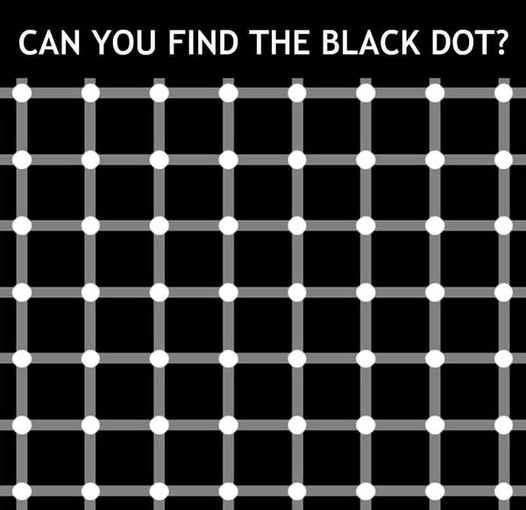
Have you ever faced a puzzle that looks easy at first but then confuses you? The picture above simply asks, “Can you find the black dot?” It seems simple at first – it’s just a grid of white dots connected by lines. But as you look at it, you might start to doubt what you see.
Many people who try to solve this puzzle give very different answers. Some think they see a black dot or even more, while others say there are none. So why does this happen?
The Nature of Optical Illusions
This puzzle uses the Hermann Grid Illusion. At the white – line intersections, some people see black dots that seem to “blink” as their eyes move. These dots aren’t real; they’re an optical illusion from how our eyes and brain handle contrast and brightness.
Human Vision Limitations
Our eyes are great, but they have limits. When looking at this grid, the retina’s ganglion cells process light and dark areas differently. This often makes us see small black dots at intersections, which disappear when we look directly at them.
Attention and Movement
Another error is thinking the black dots are still. In fact, they seem to move as you focus. This makes it feel like you’re “chasing” the dots, making the puzzle more annoying.
Overthinking the Problem
Many people spend too much time looking for hidden patterns, missing the key – it’s not about finding dots, but understanding why they seem to be there.
Don’t worry if this sounds familiar. Now that we know why the black dot is hard to find, let’s solve the puzzle step by step.
How to Solve the Illusion
- Stare Calmly: Look at the image without quickly moving your eyes. At first, you may think you see black dots in some places, but they’ll vanish when you look straight at them.
- Fix Your Gaze: Focus on one intersection. Notice how the black dot disappears when you look directly at it. Your central vision can see the truth, but your peripheral vision is still fooled by the contrast.
- Let Your Eyes Wander: Slowly move your eyes across the grid. You may see black dots briefly as you shift focus. The illusion uses your brain filling in details from your peripheral vision, where contrast can give wrong signals.
The illusion is due to lateral inhibition. The retina’s light – sensitive cells suppress neighboring cells, enhancing contrast. But this also tricks your brain into “seeing” black dots where there are none.
The Answer: There are no black dots. The illusion makes them seem to be there, but all dots are white. The black dots are just in your mind, tricking your eyes and brain.
Now that you get the puzzle, we want to hear from you. Did you see the black dots? How long did it take to figure out the illusion? Share your experience in the comments! Everyone’s perception is different, and it’s fun to compare.
Share this puzzle with friends and family. See if they can solve it or explain the illusion. It’s a great way to start a conversation and test visual perception.
Optical illusions like this are not only fun but also help us understand how our brains process visual info. Solving such puzzles sharpens our observation, boosts logical thinking, and shows us quirks of human perception.
So, can you find the black dot? The answer is simple and deep: there isn’t one. But finding this answer teaches us to face challenges with curiosity and an open mind.
If you liked this puzzle, try more. There are lots of illusions, riddles, and logic games waiting to test your brain. Have fun puzzling!